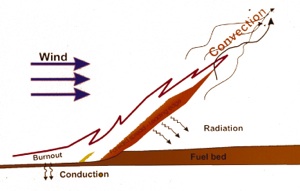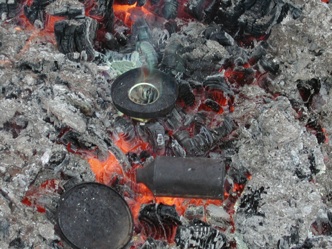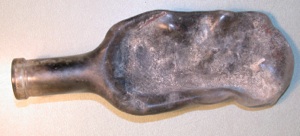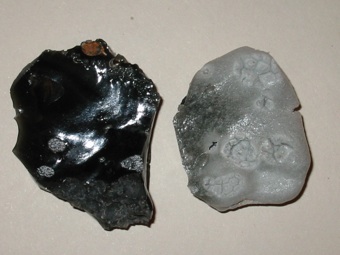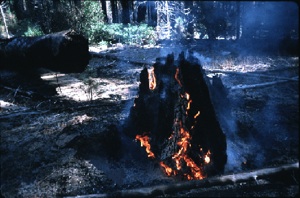References -
General Effects
Bare Bones Guide to Fire Effects on Cultural Resources For Cultural Resource Specialists
This document briefly synthesizes some of the technical information available on the effects of fire on cultural resources. This synthesis should assist cultural resource specialists with their contributions to fire management planning, compliance for prescribed fire projects, and participation in wildland fire use or wildfire events. By Kate Winthrop, of BLM, 2004
Cultural Resources - Powerpoint lecture on Cultural Resources From Scott Stephens' Wildland Fire Science Class University of California Berkeley
Fire Effects Guide - Cultural Resource Section of Fire Effects Monitoring Guide by National Wildfire Coordinating Group
Fire Effects on Cultural Resources A Bibliographic Survey of Specific and Related Literature - Bibliiography Compiled for the BLM Preservation Board by Kirk Halford, Bishop Field Office Archaeologist, 2001
BIBLIOGRAPHIES ON FIRE HAZARD MITIGATION - Bibliographic Sources Regarding the Effects of Fire on Cultural Properties.
Forest Encyclopedia Network Effects of Fire on Cultural Resources - General overview of fire effects to Cultural Resources
The Impacts of Wildland and Prescribed Fire on Archaeological Resources, Brent Buenger, 2003, Ph.D. Dissertation University of Kansas, Department of Anthropology. Through use of field-based experiments, laboratory experiments and field-based sampling of burned archaeological sites Buenger examines the potential for prescribed and wildland fire to adversely affect the interpretive integrity and preservation of archaeological materials.
See photographs of his experiments
A Burning Question: The Effects of Fire And Fire Management on Cultural Resources by Richard D. Shultz
An Examination of Fire Effects on Prehistoric Period Cultural Resources in Nevada
Prepared by Vickie Clay, Michael P. Drews, Eric Ingbar, and Charles Zeier, March 2004, The research design for this project creates a systematic framework for the observation of fire effects on those elements typically considered when determining the eligibility of prehistoric archaeological sites under National Register Criterion D. More specifically, the study focuses on the effects of fire on eligibility-related elements at the general category of prehistoric archaeological site commonly referred to as “lithic scatters and features.” Such sites comprise over 75 percent of known cultural resources in Nevada, and in most other western states as well. The study does not address elements associated with other National Register criteria (A, B, and C). This is because so few prehistoric sites in the West have been evaluated based, in part or in whole, on these criteria. Also, historic period archaeological sites are not considered in detail.
Archaeology Under Fire: the Impacts of Forest Fire on Archaeological Inquiry, Knapp, Ashleigh, 2006, 64th PLAINS ANTHROPOLOGICAL CONFERENCE, Topeka, Kansas
Articles on specific fires
Effects of the Wild Land Fire on the Resources
Very general and short article on cultural resource protection during fire in Mesa Verde in 1996.
The La Mesa Fire: Impact on Cultural Resources at Bandelier National Monument by Diane Traylor, Lyndi Hubbell, Nancy Wood, Barbara Fiedler published in Cultural Resources Management, A National Park Service Technical Bulletin, Volume 6: No. 4, pages 5-7 December 1983, CRM Bulletin
ARCHAEOLOGICAL SITES and FIRE-INDUCED CHANGES, by Clay Johnson, Ashley National Forest
A verbal version of this manuscript was presented at the Sixth Biennial Rocky Mountain Anthropological Conference, Estes Park, Colorado, September 18-20, 2003. Subsequently, an edited version of the conference papers was electronically published on CD: In: Ancient and Historic Lifeways in North America’s Rocky Mountains: Proceedings of the Rocky Mountain Anthropological Conference, Estes Park, Colorado. Edited by Robert H. Brunswig and William B. Butler, 2004.
Save Our Heritage Organization page on historic structures impacted by the 2007 So Cal Fires
See more information by following these links:
Bone Ceramics Chert Obsidian Historic artifacts Archival Materials
Fire Cracked Rock
Fire Cracked Rock Bibliography
House, J. H., and Smith, J. W., 1975. Experiments in the Replication of Fire-cracked Rock. In: Schiffer, M. B., and House, J. H., (Eds.), The Cache River Archeological Project: An Experiment in Contract Archeology, pp. 75-80. McDowell-Loudan, E. E., 1983. Fire-cracked rock: preliminary experiments to determine its nature and significance in archaeological contexts. Chesopiaean 21, 20-29.
McParland, P., 1977. Experiments in the Firing and Breaking of Rocks. Calgary Archaeologist 5.
Historic structures
Sandstone (Architectural)
Fire will damage architectural stone. Above about 300 C (572 F) sandstone will begin to oxidize and at higher temperatures (pervasive at 700 C, 1292 F) it will spall and fracture. These effects can significantly alter features constructed of this material and may constitute a significant effect to sites with these features (Buenger 2003).
Adobe
Adobe bricks and mortar and rammed earth walls are created from non-flammable sand, silt, and clay. These materials may be mixed with straw, however, and construction of adobe structures will often include wooden poles and posts, which may burn. Walls may be smoothed with adobe plaster. When intact, an adobe structure will resist fire. Plaster that is made with gypsum will spall when exposed to sufficient heat, which may expose more flammable parts of a structure. If the straw used in the adobe burns, the structure may also be weakened (Haecker n.d.).
Cement-mortared Fieldstone, Firebrick, Cinder Block, Cement Aggregate
These materials are generally resistant to fire. Low-fired, non-commercial, locally made brick may weaken and crumble in a hot fire. Hot fires will also calcinate lime-based mortar, causing it to crumble and the wall to eventually collapse. Masonry and cinder block may spall, resulting in damage to the surface of the structure (Haecker n.d.)
Haecker, C. M., 2001, Effects of Fire on Historic Structures and Historic Artifacts. Cultural Resource Protection and Fire Management Planning, Tucson, Arizona.
Johnson, A., 1991. Post-fire Identification of Nineteenth Century Wooden Structures. Archaeology in Montana 32, 33-48.
FIRE LOSS TO HISTORIC BUILDINGS
Lithics
See individual pages on Chert and Obsidian
Basalt
Fire can produce changes in basalt including spalling, potlidding, crazing, and fracturing; these effects possibly result from rapid cooling. There is little experimental data for fire effects on basalt. One study indicates that spalling or flaking may occur at temperatures around 350 – 400 C (662 - 752 F) (Deal n.d.).
Groundstone
Rock types vary in their response to fire. Sandstone reportedly cracks or fractures at a lower temperature than basalt. Granites and quartzites withstand higher temperatures. Severe wildfire may cause portable groundstone to crack or fracture. Thermal shock—such as rapid heating or cooling--can cause fracturing and exfoliating of groundstone artifacts, including bedrock mortars. Burning or smoldering fuels on groundstone artifacts or features (e.g. a fallen tree on a bedrock mortar) may contribute to increased damage during a fire. As is true for other tool types, longer exposures to heat and/or hotter fires increases the potential for artifact damage (Deal n.d., Buenger 2003).
Ahler, S. A., 1983. Heat Treatment of Knife River Flint. Lithic Technology 12, 1-8.
Bleed, P., and Meier, M., 1980. An Objective Test of Effects of Heat Treatment of Flakeable Stone. American Antiquity 45, 502-507.
Gregg, M. L., and Grybush, R. J., 1976. Thermally Altered Siliceous Stones from Prehistoric Contexts: Intentional vs. Unintentional Alteration. American Antiquity 41, 189-192.
Griffiths, D. R., Bergman, C. A., Clayton, C. J., Ohnuma, K., Robins, G. V., and Seely, N. J., 1987. Experimental Investigation of the Heat Treatment of Flint, The Human Uses of Flint and Chert: Proceedings of the Fourth International flint Symposium, held at Brighton Polytechnic, 10-15 April 1983. Cambridge University Press, Cambridge, pp. 43-52.
Hester, J. J., 1973. Ethnographic Evidence for the Thermal Alteration of Siliceous Stone. Tebiwa 15, 63-65.
Patterson, L., 1995. Intentional Heat Treatment: A Reply to Rondeau. Lithic Technology Journal 20, 136-137.
Purdy, B. A., 1974. Investigations concerning the thermal alteration of silica minerals: an archaeological approach. Tebiwa 17, 37-66.
Purdy, B. A., and Brooks, H. K., 1971. Thermal alteration of silica minerals: An archaeological approach. Science 173, 322-325.
Rick, J. W., 1978. Heat-altered cherts of the lower Illinois Valley, an experimental study in prehistoric technology. Northwestern University Archaeology Program, Evanston, Illinois.
Robins, G. V., Steely, N. J., McNeil, D. A. C., and Symons, M. R. C., 1978. Identification of ancient heat treatment in flint artifacts by ESR spectroscopy. Nature 276, 703-704.
Rondeau, M. F., 1995. Thermal damage does not equal heat treatment. Lithic Technology Journal 20, 135-137.
Rowney, M., and White, J. P., 1997. Detecting heat treatment of silcrete: experiments with methods. Journal of Archaeological Science 24, 649-657.
Schindler, D. L., Hatch, J. W., Hay, C. A., and Bradt, R. C., 1972. Aboriginal thermal alteration of a central Pennsylvania jasper: analytical and behavioral implications. American Antiquity 47, 526-544.
Rebutal
Weymouth, J. W., and Manderville, M., 1975. An X-ray diffraction study of heat treated chert and its archaeological implications. Archaeometry 17, 61 - 67.
Whyte, T. R., Advantages and disadvantages of burned lithic artifacts in the study of archaeological sites. the 40th Annual Southeastern Archaeological Conference, 1983.
Whyte, T. R., 1984. Lithic artifact burning and archaeological deposit formation on three early archaic sites in east Tennessee, University of Tennessee, Department of Anthropology, Knoxville.
Pollen
Cummings, L. S., 1991. Pollen and Macrofloral Analysis at Nine Sites in Grand Teton National Park, Wyoming: 1988 Field Season. In: Connor, M. A., Cannon, K. P., Matz, S. E., Carlevato, D. C., and Winchell, C. A., (Eds.), Jackson Lake Archeological Project: The 1987 and 1988 Field Work. Midwest Archeological Center, Lincoln, Nebraska, pp. 430-453.
Fish, S., 1989. Long Mesa Fire: Fire Effects on Pollen: An Evaluation.
Ford, R. I., 1990. Appendix B. Ethnobotanical Consequences of the La Mesa Fire, Bandelier National Monument. In: Traylor, D., Hubbel, L., Wood, N., and Fiedler, B., (Eds.), The 1977 La Mesa Fire Study: An Investigation of Fire and Fire Suppression Impact on Cultural Resources in Bandelier National Monument. National Park Service, Division of Anthropology, Branch of Cultural Resources Management, Santa Fe, pp. 147-152.
Ford, R. I., 1990. Ethnobotanical Consequences of the La Mesa Fire, Bandelier National Monument.
Scott, L. J., 1978. Pollen analysis of three sites in the La Mesa study area, Report prepared for Southwest Region, National Park Service, Santa Fe New Mexico In fulfillment of Purchase Order No. PX7029-7-0089. National Park Service, Division of Anthropology, Branch of Cultural Resources Management, Santa Fe, pp. 153-164.
Scott, L. J., 1990. Appendix C. Pollen analysis of three sites in the La Mesa study area. In: Traylor, D., Hubbel, L., Wood, N., and Fiedler, B., (Eds.), The 1977 La Mesa Fire Study: An investigation of fire and fire suppression impact on cultural resources in Bandelier National Monument. National Park Service, Division of Anthropology, Branch of Cultural Resources Management, Santa Fe, pp. 153-164.
Rock Art
Fire has a high potential for damage to rock art. Though there are no specific temperature guidelines for rock art, fire effects include soot smudging and discoloration from smoke, which obscure the rock art images; degradation of the rock surface from spalling, exfoliation, and increased weathering; changes in organic paints due to heat; and damage to rock varnish which may destroy its potential to date the art (Tratebas 2004, Kelly and McCarthy 2001).
Fire retardants, slurry, foam, and water should never be dumped/ sprayed on rock art during a fire.
Rock Art and Fire - Some basics on Rock Art and Fire
Blackwelder, E., 1927. Fire as an Agent in Rock Weathering. Journal of Geology 35, 134-140.
Cavaioli, M., 1991. Fire Reveals New Pictographs at the Kuel Site: The Effects of Wildfire on Pictograph Sites. Rock Art Papers # 27 8, 81-83.
Cole, S. J., 1997. Documentation of Battleship Rock Petroglyph Site, MV2469, After the 1996 Soda Canyon Wild Fire. Report prepared for Mesa Verde National Park,, Colorado.
Dandridge, D. E., 1999. Rock Art, Vegetation and Fire. La Pintura Spring 1999, 4-5.
Dean, J. C., 1999. Condition assessment of three rock art sites: Alibates Flint Quarries National Monument, Texas. Dean & Associates Conservation Services, Portland, Oregon.
Jones, A. T., and Ryan, K. C., ca. 2001. Wildland Fire in Ecosystems: Effects of Fire on Cultural Resources and Archeology. USDA Forest Service, Rocky Mountain Research Station, Fort Collins, Colorado.
Kelly, R., and McCarthy, D. F., 2001. Effects of Fire on Rock Art. American Indian Rock Art 27, 169-176.
Kolber, J., 1998. Burned petroglyphs in Deadman Wash. La Pintura 24, 1-2.
Nealson, E., 1995. Fire as a Geomorphic Agent in Rock Weathering: The Effect of Rock Size on Weathering Efficiency under Simulated Forest Fire Conditions, (Master’s thesis), University of Iowa.
Noxon, J. S., and Marcus, D. A., 1983. Wildfire-induced cliff face exfoliation and potential effects on cultural resources in the Needles District of Canyonlands National Park, Utah. Southwestern Lore 49, 1-8.
Scott, D. D., 1979. Don't burn that wickiup! A value at risk. Some considerations of cultural resources in fire management. Bureau of Land Management, Montrose, Colorado, pp. 1-11.
Tratebas, A., Cerveny, N., and Dorn, R., 2004. The Effects of Fire on Rock Art: Microscopic Evidence Reveals the Importance of Weathering Rinds. Physical Geography 25, 313-333.
Soil
Beadle, N. C. W., 1940. Soil Temperature during forest fires and its effects on the survival of vegetation. Journal of Ecology 28, 180-192.
Boyer, D., and Dell, J. D., 1980. Fire Effects on Pacific Northwest Forest Soils. Forest Service USDA Pacific Northwest Region, Watershed Management and Aviation and Fire Management.
Campbell, G. S., Jungbauer, J. D., Bidlake, W. R., and Hungerford, R. D., 1994. Predicting the Effect of Temperature on Soil Thermal Conductivity. Soil Science 158, 307-313.
Campbell, G. S., Jungbauer, J. D., Bristow, K. L., and Hungerford, R. D., 1995. Soil Temperature and Water Content Beneath a Surface Fire. Soil Science 159, 363-375.
Connor, M. A., and Cannon, K. P., 1991. Forest Fires as a Site Formation Process in the Rocky Mountains of Northwestern Wyoming. Archaeology in Montana 32, 1-14.
Connor, M. A., Cannon, K. P., and Carlevato, D. C., 1989. The Mountains Burnt: Forest Fires and Site Formation Processes. North American Archaeologist 10, 293-310.
DeBano, L. F., 2000. The role of fire and soil heating on water repellency in Wildland environments: a review. Journal of hydrology 231/232, 195.
DeBano, L. F., Rice, R. M., and Conrad, C. E., 1979. Soil Heating on Chaparral Fires: Effects on Soil Properties, Plant Nutrients, Erosion, and Runoff. USDA Forest Service, Pacific Southwest Forest Range Experiment Station, Berkeley, California.
Duriscoe, D., N.d. Effects of Fire on Physical Properties of Chaparral Soils., Unpublished Manuscript, U.S. Forest Service.
Evans, K. G., Saynor, M. J., and Willgoose, G. R., 1998. Changes in Hydrology, Sediment Loss and Microtopography of a Vegetated Mine Waste Rock Dump Impacted by Fire. Land Degradation and Development 10, 507-522.
Gifford, G., 1981. Impact of Burning Pinyon-Juniper Debris on Select Soil Properties. Journal of Range Management 34.
Hinshelwood, A., 1996. Boreal Forest Fire Ecology and Archaeological Site Formation: An Example from Northern Ontario. Ontario Archaeology 62, 63-92.
Hoyer, S. J., 1982. The Effects of Prescribed Fire on Soil Properties.
Lintz, C., 1989. Experimental thermal discoloration and head conductivity studies of caliche from eastern new Mexico. Geoarchaeology 4, 319-346.
J.C. Neff, J.W. Harden, and G. Gleixner, Fire effects on soil organic matter content, composition, and nutrients in boreal interior Alaska
Nidal, H. A.-H., and Reeder, R. C., 2000. Soil Thermal Conductivity: Effects of Density, Moisture, Salt Concentration, and Organic Matter. Soil Science Society American Journal 64.
Shoemaker, K. W., 1975. Selected bibliography of studies in soil ecology with emphasis on the influence of fire on soil. Grand Canyon National Park.
Wagle, R. F., and J. H. Kitchen, J., 1972. Influence of Fire on Soil Nutrients in a Ponderosa Pine Type. Ecology 53, 118-125.
Wells, C. G., Campbell, R. E., DeBano, L. F., Lewis, C. E., Fredriksen, E. C., Froelich, R. C., and Dunn, P. H., 1979. Effects of fire on soil: A state-of-knowledge review, national fire effects workshop, Denver, General Technical Report No. WO-7. USDA Forest Service, Washington, D.C.
